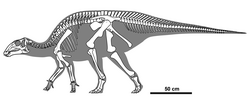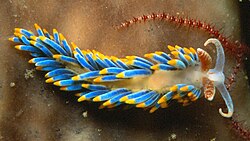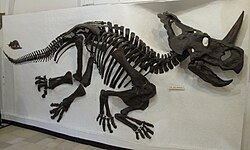The International Code of Phylogenetic Nomenclature, known as the PhyloCode for short, is a formal set of rules governing phylogenetic nomenclature. Its...
28 KB (2,939 words) - 15:03, 23 May 2025
taxa, including the PhyloCode, the Duplostensional Nomenclatural System, and circumscriptional nomenclature. The botanical code is applied primarily...
26 KB (2,549 words) - 01:55, 1 June 2025
Queiroz, Kevin (29 April 2020). International Code of Phylogenetic Nomenclature (PhyloCode): A Phylogenetic Code of Biological Nomenclature. Boca Raton, Florida:...
69 KB (6,825 words) - 06:32, 3 June 2025
used as a homonym for Pelecaniformes. Pelecanimorphae is defined in the PhyloCode by George Sangster and colleagues in 2022 as "the least inclusive clade...
6 KB (411 words) - 06:23, 10 December 2024
of the Nodosauridae to be Cedarpelta. Following the publication of the PhyloCode, Nodosauridae needed to be formally defined following certain parameters...
32 KB (2,076 words) - 11:15, 3 June 2025
in all nomenclatural systems for taxonomists; for instance, the PhyloCode, the code of phylogenetic nomenclature, does not require absolute ranks. Taxa...
60 KB (5,908 words) - 04:41, 19 May 2025
tilletti. In 2021, Iguanodontia was given a formal definition under the PhyloCode: "The smallest clade containing Dryosaurus altus, Iguanodon bernissartensis...
19 KB (1,620 words) - 04:49, 26 May 2025
stenops". In 2021, Neornithischia was given a formal definition under the PhyloCode: "The largest clade containing Iguanodon bernissartensis and Triceratops...
14 KB (953 words) - 00:47, 5 May 2025
; de Queiroz, Kevin (2000). International Code of Phylogenetic Nomenclature (PhyloCode): A Phylogenetic Code of Biological Nomenclature. Boca Raton, Fl:...
11 KB (1,223 words) - 09:14, 9 March 2025
priority before the PhyloCode is implemented to govern it. In fact, the name Ornithosuchia may be "illegal" under the PhyloCode because it does not include...
22 KB (2,072 words) - 23:29, 23 May 2025
nomenclature is regulated currently by the International Code of Phylogenetic Nomenclature (PhyloCode). Phylogenetic nomenclature associates names with clades...
37 KB (4,675 words) - 14:21, 23 May 2025
Euoplocephalus, and Saichania. Ankylosaurinae is formally defined in the PhyloCode as "the largest clade containing Ankylosaurus magniventris, but not Shamosaurus...
5 KB (264 words) - 03:06, 5 May 2025
ichthyornithines and the hesperornithines. This clade is defined in the PhyloCode by Juan Benito and colleagues in 2022 as "the smallest clade containing...
7 KB (574 words) - 00:44, 5 May 2025
Species (section Identification codes)
specialists, is not governed by the Codes of Zoological or Botanical Nomenclature, in contrast to the PhyloCode, and contrary to what is done in several...
102 KB (10,502 words) - 16:05, 23 May 2025
2021 when the group name and definition was formalized following the PhyloCode. Phylogenetic and morphological studies have differed on the inclusion...
22 KB (1,934 words) - 09:50, 24 May 2025
Galloanserae (ducks, chickens and kin). This group is defined in the PhyloCode by George Sangster and colleagues in 2022 as "the most inclusive crown...
30 KB (1,325 words) - 07:35, 2 June 2025
Saurolophus". In 2021, Madzia et al. registered Brachylophosaurini in the PhyloCode and formally defined it as "The largest clade containing Brachylophosaurus...
15 KB (1,148 words) - 20:18, 25 May 2025
the derived taxa that lack them. The clade is formally defined in the PhyloCode as "the largest clade containing Hadrosaurus foulkii, but not Probactrosaurus...
11 KB (866 words) - 00:51, 5 May 2025
International Code of Zoological Nomenclature Virus nomenclature – used in Virus classification Enzyme nomenclature PhyloCode (the International Code of Phylogenetic...
33 KB (4,003 words) - 10:03, 13 February 2025
modern birds than to the enantiornithines. This group was defined in the PhyloCode by Juan Benito and colleagues in 2022 as "the largest clade containing...
12 KB (748 words) - 23:59, 24 May 2025
colleagues in 2024 gave a formal definition for Thyreophoroidea in the PhyloCode as "the smallest clade containing Ankylosaurus magniventris, Scelidosaurus...
12 KB (994 words) - 13:11, 23 May 2025
also included. In 2021, Daniel Madzia redefined Rhabdodontomorpha in the PhyloCode as "the largest clade containing Rhabdodon priscus, but not Iguanodon...
8 KB (681 words) - 00:40, 5 May 2025
species of basal angiosperms. It is a name created under the rules of the PhyloCode system of phylogenetic nomenclature. While such a clade with a similar...
12 KB (1,182 words) - 02:18, 20 April 2025
Lepidosauromorpha (in PhyloCode known as Pan-Lepidosauria) is a group of reptiles comprising all diapsids closer to lizards than to archosaurs (which...
9 KB (736 words) - 18:48, 24 May 2025
scientific meetings and is overseeing the completion and implementation of the PhyloCode. The International Society for Phylogenetic Nomenclature (ISPN) was established...
4 KB (400 words) - 17:02, 22 October 2023
2023-04-17. Dayrat, B. (2005). "Advantages of naming species under the PhyloCode: An example of how a new species of Discodorididae (Mollusca, Gastropoda...
44 KB (4,453 words) - 22:12, 23 May 2025
discovered on all continents. The group has officially been defined under the PhyloCode as the largest clade containing Saltasaurus loricatus, but not Giraffatitan...
5 KB (228 words) - 00:38, 5 May 2025
Lambe in 1915, with Centrosaurus as the type genus. It is defined in the PhyloCode as "the largest clade containing Centrosaurus apertus, but not Chasmosaurus...
22 KB (1,878 words) - 06:30, 19 May 2025
referred to as Hypsilophodontia. That clade is formally defined in the PhyloCode as "the smallest clade within Ornithopoda containing Hypsilophodon foxii...
23 KB (1,784 words) - 23:13, 4 May 2025
needed] the group[clarification needed] has been redefined under the PhyloCode as a node-based clade comprising the Canellales, Laurales, Magnoliales...
24 KB (2,444 words) - 15:01, 26 May 2025
























